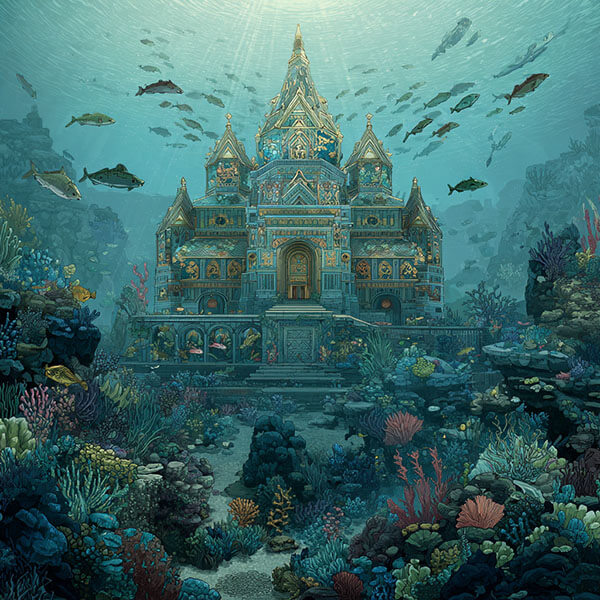
Ahtola
Realm in the Kalevala
The Realm of Water
Karelian / Finnish Mythology
Ahtola is the underwater realm in Finnish mythology and the Kalevala. While it encompasses all waterways, fresh and salt, the palace of Ahti resides in the sea. Ahtola is a place that produces bountiful resources, as fish is a staple of the Finnish diet.
Part of the bountiful nature of the land results from Ahti’s acquisition of the Sampo, a legendary artifact that produces unlimited resources. Ahti, who goes by Ahto in the Kalevala, and his wife, Vellamo, rule the kingdom of Ahtola. Together, they have many beautiful daughters often sought after by suitors.
Ahtola’s Geography
Ahtola is a vast and mysterious place. The location of the Palace of Ahtola is a mystery, but many adventurers sought the treasures contained within it. The kingdom spans the length of the ocean, rivers, and lakes throughout Finland, leading to a deep regard for the power held within it.
Palace of Ahtola – Ahti and Vellamo rule the underwater kingdom from the Palace of Ahtolo. The palace itself is adorned in jewels, fish scales, and houses the daughters of the deities. These maidens are renowned for their beauty and mystery by those who dwell on the land.
The Endless Sea – The sea is a place of endless bounties yet routh with peril. As such, adventurers developed superstitions surrounding etiquette while sailing. The sea was often seen as a living being, changing temperament on a whim just as the storms and waves change course. Due to this, sailors often paid tributes and offerings to Ahti before setting out on the open seas.
Everchanging Seabed – The seas represent a state of constant change, evolution, and mystery. The shifting lands below the sea promote the idea of the ocean itself being a living being. The temperament of the ocean is unpredictable and, as such, commands respect for those who sail upon it.
In one Canto within the Kalevala, Väinämöinen’s music enthralled Ahti, causing him to reveal himself. This contributes to the notion that the sea is a mutable place.
Rivers – Throughout the Kalevala, rivers serve as a boundary between worlds. The River of Tuoni is an excellent example of this. It is the boundary that separates the realms of the living and the dead. Once crossed, souls are unable to make their way back without Tuonela’s permission.
Rivers symbolize peril, transition, and separation between worlds, sometimes alluding to death. While they are an essential facet of Finnish geography, they are not to be trifled with.
Lakes – Lakes are a place that brings nourishment, bounty, and life to the Finns. After all, Finland is the “Land of a Thousand Lakes.” They are a source of magic, mystery, and mystical spirits. Most of the time, they are a place of overflowing bounty. However, lakes can also prove treacherous. As with the other geographical regions of Ahtola, the lakes command respect in accordance with other aspects of nature.
Inhabitants of Ahtola
In addition to being ruled by Ahti and Vellami, Ahtola is known for their daughters, who are described as beautiful maidens. In one instance, after the death of Aino, Väinämöinen seeks the Palace of Ahti to court the beautiful maidens. Nevertheless, his requests land upon the deaf ears of Ahti.
Additionally, magical spirits, sea creatures, and fish who provide sustenance for Finns inhabit Ahtola. Inhabitants of Ahtola include:
Symbolism of Ahtola
Ahtola symbolizes the power of the sea, virility, and masculinity. It is a place that contains a plethora of bounty, despite remaining mysterious and dangerous. Finnish culture appreciates the bounties of the sea, lakes, and rivers.
Ahti rules the sea and guards his treasures fiercely. That’s not to say that their acquisition is impossible. However, it takes courage, grit (sisu in Finnish), luck, and wit to obtain these bounties. Fishermen, travelers, and warriors would pray to Ahti to seek favor before setting out on the sea.
Mentions in the Kalevala
The first mention of Ahtola is after Aino’s death. While fishing, Väinämöinen sings a song beckoning Ahto to show the way to his palace and maidens of the deep.
Next, Ahtola plays a significant role in the saga, where the heroes attempt to steal the Sampo. As Louhi chases the heroes, she transforms into a monstrous eagle with soldiers on her back. During the ensuing pursuit, Väinämöinen accidentally shatters the Sampo and sends it overboard. Ultimately, the Sampo is lost to the depths of the sea.
Despite Väinämöinen’s powerful magic, Ahto denies his prayers and requests to return the Sampo to the Land of Kalevala. The Sampo remains in the kingdom of Ahtola and produces the bounties of the sea Finns enjoy to this day.
